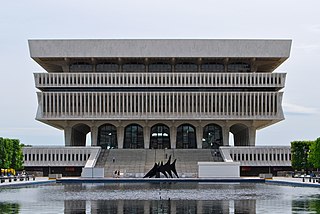
The Field Museum of Natural History (FMNH), also known as The Field Museum, is a natural history museum in Chicago, Illinois, and is one of the largest such museums in the world. The museum is popular for the size and quality of its educational and scientific programs, and its extensive scientific specimen and artifact collections. The permanent exhibitions, which attract up to 2 million visitors annually, include fossils, current cultures from around the world, and interactive programming demonstrating today's urgent conservation needs. The museum is named in honor of its first major benefactor, Marshall Field, the department-store magnate. The museum and its collections originated from the 1893 World's Columbian Exposition and the artifacts displayed at the fair.

The National Museum of Natural History (NMNH) is a natural history museum administered by the Smithsonian Institution, located on the National Mall in Washington, D.C., United States. It has free admission and is open 364 days a year. With 4.4 million visitors in 2023, it was the second most-visited museum in the United States.

The Burke Museum of Natural History and Culture is a natural history museum on the campus of the University of Washington, in Seattle, Washington, United States. It is administered by the UW College of Arts and Sciences. Established in 1899 as the Washington State Museum, the museum traces its origins to a high school naturalist club formed in 1879. The museum is the oldest in Washington state and boasts a collection of more than 16 million artifacts, including the world's largest collection of spread bird wings. The Burke Museum is the official state museum of Washington.

The Indian Museum is a massive museum in Central Kolkata, West Bengal, India. It is the ninth oldest museum in the world and the oldest and largest museum in India and Asia, by size of collection. It has rare collections of antiques, armour and ornaments, fossils, skeletons, mummies and Mughal paintings. It was founded by the Asiatic Society of Bengal in Kolkata (Calcutta), India, in 1814. The founder curator was Nathaniel Wallich, a Danish botanist.

The Florida Museum of Natural History (FLMNH) is Florida's official state-sponsored and chartered natural history museum. Its main facilities are located at 3215 Hull Road on the campus of the University of Florida in Gainesville.

National Museums Scotland is an executive non-departmental public body of the Scottish Government. It runs the national museums of Scotland.

The Sam Noble Oklahoma Museum of Natural History is the officially designated natural history museum for the State of Oklahoma, located on the campus of the University of Oklahoma. The museum was founded in 1899 by an act of the Oklahoma Territorial Legislature. Its current building was completed in 1999 under the leadership of Michael A. Mares, who was director from 1983-2003 and from 2008-2018. The museum contains more than 10 million objects and specimens in 12 collections. The current building is a 198,000-square-foot facility with almost 50,000 square feet of public space, with five permanent and two temporary galleries and exhibits that provide an in-depth tour of Oklahoma's natural and cultural history. The remainder of the facility is dedicated to housing museum collections, laboratories, libraries, and offices. It is one of the world's largest university-based natural history museums.
The Western Australian Museum is a statutory authority within the Culture and the Arts Portfolio, established under the Museum Act 1969.

The New York State Museum is a research-backed institution in Albany, New York, United States. It is located on Madison Avenue, attached to the south side of the Empire State Plaza, facing onto the plaza and towards the New York State Capitol. The museum houses art, artifacts, and ecofacts that reflect New York’s cultural, natural, and geological development. Operated by the New York State Education Department's Office of Cultural Education, it is the oldest and largest state museum in the US. Formerly located in the State Education Building, the museum now occupies the first four floors of the Cultural Education Center, a ten-story, 1,500,000-square-foot (140,000 m2) building that also houses the New York State Archives and New York State Library.

Maidstone Museum is a local authority-run museum located in Maidstone, Kent, England, featuring internationally important collections including fine art, natural history, and human history. The museum is one of three operated by Maidstone Borough Council. The building is Grade II* listed.

The University of Oregon Museum of Natural and Cultural History is a natural history museum on the University of Oregon campus, in Eugene, Oregon, United States of America. The museum headquarters and public spaces are located at 1680 East 15th Avenue in a building inspired by the design of Pacific Northwest Native longhouses.
The Georgia Museum of Natural History is the U.S. state of Georgia's museum of natural history located in Athens, Georgia. The museum has eleven different collections in Anthropology, Arthropods, Botany, Geology, Herpetology, Ichthyology, Invertebrate, Mammalogy, Mycology, Ornithology, and Zooarchaeology. In addition, there are exhibitions, archives, and entertainment for children. The Exhibit Gallery is free and open to the public during scheduled hours. People can schedule a tour to visit the collections by appointment.

The New Jersey State Museum is located at 195-205 West State Street in Trenton, in the U.S. state of New Jersey. The museum's collections include natural history specimens, archaeological and ethnographic artifacts, and cultural history and fine art objects. Exhibitions, educational activities, research programs, and lectures are also offered. The museum, a division of the New Jersey Department of State, includes a 140-seat planetarium and a 384-seat auditorium.
The Coats–Hines–Litchy site is a paleontological site located in Williamson County, Tennessee, in the Southeastern United States. The site was formerly believed to be archaeological, and identified as one of only a very few locations in Eastern North America containing evidence of Paleoindian hunting of late Pleistocene proboscideans. Excavations at the site have yielded portions of four mastodon skeletons, including portions of one previously described as being in direct association with Paleoindian stone tools. The results of excavations have been published in Tennessee Conservationist, and the scholarly journals Current Research in the Pleistocene, Tennessee Archaeology, and Quaternary Science Reviews. The site was listed on the National Register of Historic Places on July 12, 2011.

The Khon Kaen National Museum was opened by King Bhumibol Adulyadej on 20 December 1972. Most of the exhibits are concerned with history, art, and archaeology. Besides the museum's permanent collection, temporary exhibitions are shown throughout the year.

The University of Michigan Museum of Natural History (UMMNH) is a natural history museum of the University of Michigan in Ann Arbor, Michigan, United States.
Madeline Kneberg Lewis (1903–1996) was an American archaeologist and professor of anthropology at the University of Tennessee. She is most famous for her work on excavations in the Tennessee Valley, beginning in the 1930s. She was instrumental in establishing the anthropology department at the University of Tennessee as well as the Frank H. McClung Museum. She was the first female full professor at Tennessee outside of home economics and among the first prominent female archaeologists in the United States.
Hiwassee Island, also known as Jollys Island and Benham Island, is located in Meigs County, Tennessee, at the confluence of the Tennessee and Hiwassee Rivers. It is about 35 mi (56 km) northeast of Chattanooga. The island was the second largest land mass on the Tennessee River at 781 acres before the Tennessee Valley Authority created the Chickamauga Lake as a part of the dam system on the Tennessee River in 1940. Much of the island is now submerged, leaving 400 acres above the waterline.













